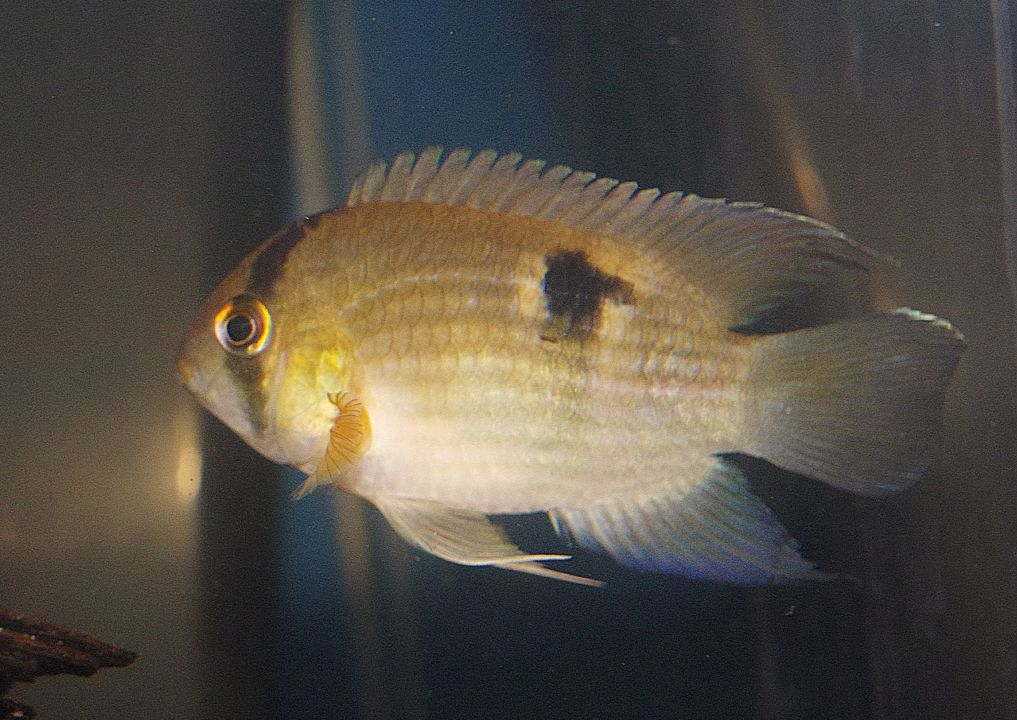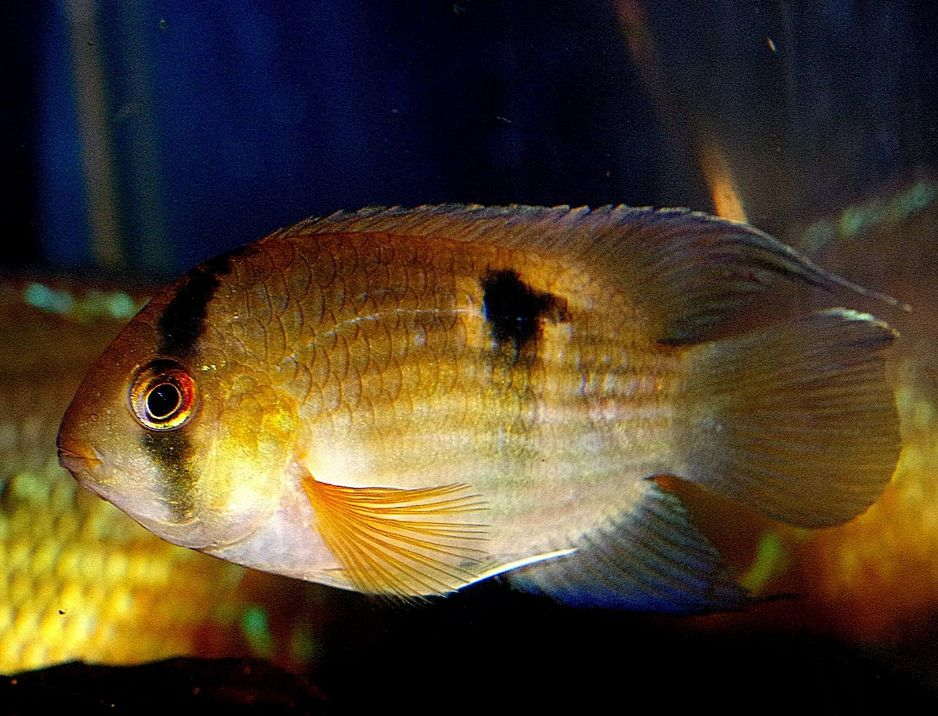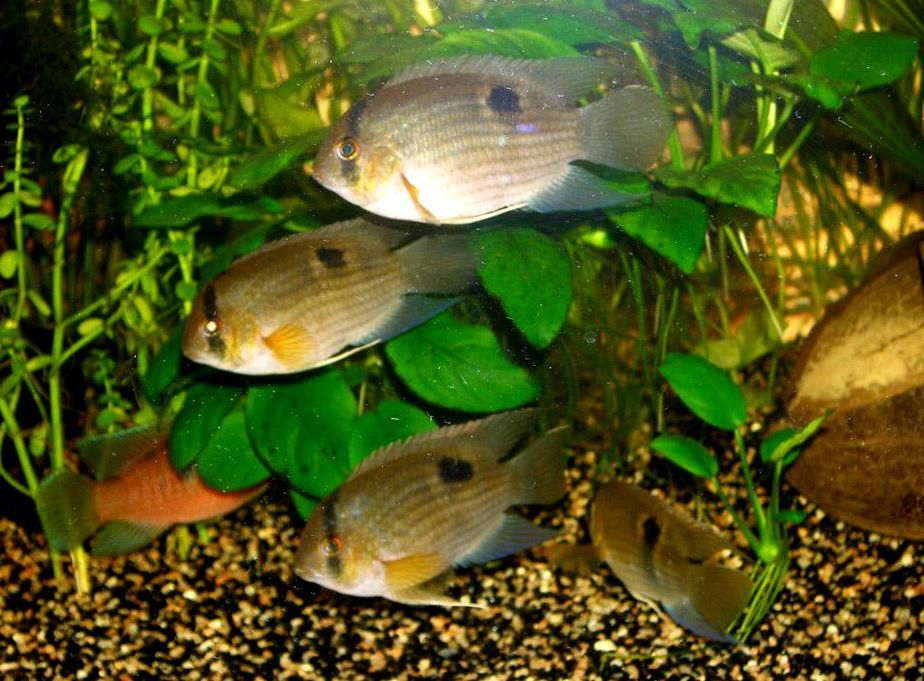The keyhole cichlid is a captivating yet underrated freshwater fish, often overlooked in pet shops and by breeders. Despite its subtle coloring and shy nature, this fish is a peaceful and intelligent addition to community tanks. Unlike many other cichlid species that boast bright colors but exhibit aggressive behavior, the keyhole cichlid’s calm temperament makes it an ideal choice for a harmonious aquarium environment. Its gentle demeanor allows it to coexist well with a variety of tankmates, showcasing that beauty and personality can indeed go hand in hand.

Contents
Habitat in the wild
The keyhole cichlid, a member of the cichlid family, is a remarkable freshwater fish native to tropical South America. Cichlids are known for their diverse appearances and complex behaviors, including parental care and territoriality. Most species are found in Africa, Central and South America, with a few in Asia. The keyhole cichlid is unique within its genus, Cleithracara, and thrives in the Orinoco River estuary, extending from the Barima River in Guyana to the Ouanary River in French Guiana.
In its natural habitat, the keyhole cichlid prefers slow-moving rivers and streams surrounded by tropical forests. The bottoms of these waters are often covered with fallen leaves, branches, and various fruits, contributing to a rich, brown coloration due to high concentrations of tannins. These fish are known for their ability to hide among the foliage, providing them with a sense of security. They also play a role as “cleaners” in the aquarium, as they feed on leftover food and algae, helping to maintain a balanced ecosystem.
While wild specimens are rarely available in pet shops, most keyhole cichlids sold today are bred in fish hatcheries and private farms, making them a more accessible option for aquarists looking for a peaceful and visually intriguing fish. They typically exhibit a range of colors, from soft browns to hints of blue and yellow, depending on their environment. Additionally, keyhole cichlids are known for their digging behavior, which can help aerate the substrate and create a more dynamic habitat within the aquarium.
Description
Size
How big do keyhole cichlids get? The keyhole cichlid is relatively small compared to many other cichlid species. Males can grow up to 7-10 cm (approximately 4 inches) in length, slightly larger than females, who typically max out around 6-8 cm (2.5-3 inches). Males also have longer rays on their dorsal and anal fins, which often extend to the tip of their tail fin. This modest size makes keyhole cichlids well-suited for medium-sized aquariums, where they can thrive alongside various peaceful fish in a community setup.
Lifespan
In captivity, keyhole cichlids have a typical lifespan of about 5 to 10 years, though some individuals may live longer with optimal care. Their longevity can be influenced by several factors, including water quality, diet, tank conditions, genetics, and overall health. Providing a stable environment and a balanced diet can significantly enhance their quality of life and lifespan.
Color
Keyhole cichlids are characterized by their striking coloration. They have a dark stripe that runs from the base of the dorsal fin, through the eye, and down to the bottom of the gill cover. Closer to the tail, a group of dark spots forms a pattern resembling a keyhole, which is the source of their name. Their base coloration can vary, often presenting shades of brown, yellow, or even blue depending on their environment. This unique coloration not only aids in camouflage among the leaf litter but also adds visual interest to aquariums.
Behavior
Keyhole cichlids are known for their peaceful nature, making them excellent candidates for community tanks. They tend to be shy and prefer to hide among plants and decorations. Despite their timidity, they can display curious and interactive behavior, especially when they become accustomed to their surroundings. They are also known to form bonds with their tank mates and may exhibit territoriality during breeding.
| Characteristic | Description |
|---|---|
| Scientific Name | Cleithracara maronii |
| Common Name | Keyhole Cichlid, maroni cichlid |
| Family | Cichlidae |
| Origin | South America (Amazon River basin and tributaries) |
| Size | Up to 4-5 inches (10-13 cm) |
| Lifespan | 5-10 years (in captivity) |
| Temperament | Peaceful, relatively non-aggressive |
| Difficulty Level | Easy to moderate |
| Aquarium Size | 30 gallons (113 liters) or larger |
| Water Conditions | – Temperature: 75-82°F (24-28°C) |
| – pH: 6.5 – 7.5 | |
| – Water hardness: 5-12 dGH | |
| Diet | Omnivorous – High-quality pellets, flakes, |
| and live/frozen foods (brine shrimp, bloodworms, | |
| daphnia, etc.) | |
| Tank Setup | – Plenty of live plants |
| – Hiding spots (driftwood, rocks, caves) | |
| – Substrate: Soft sand or fine gravel | |
| Compatibility | Peaceful community fish (avoid aggressive species) |
| Breeding Behavior | Substrate spawners, exhibit parental care |
Difficulties in keeping
The keyhole cichlid is a small, peaceful fish that is both undemanding and engaging, making it an excellent choice for beginner aquarists. While it generally exhibits a calm demeanor, it’s essential to remember that it is still a cichlid species. Therefore, it may not be suitable for community tanks containing smaller fish, as its natural instincts could lead to potential predation or territorial behavior.

Care and keeping in a tank
Tank Size
The recommended tank size for keyhole cichlids varies based on the number of individuals and potential tank mates. While these fish are relatively small, they require enough space to swim comfortably and establish territories. For a breeding pair, a minimum tank volume of 30 gallons (113 liters) is recommended. Keyhole cichlids are monogamous and form strong pair bonds.
When keeping them in a larger group, it’s crucial to remember that they are territorial. Therefore, the tank should have plenty of shelters to create separate areas. If you plan to keep multiple keyhole cichlids or include other peaceful community fish, aim for a tank size of at least 50 gallons (189 liters) or more, depending on the number and size of the fish.
Tank Decor
Keyhole cichlids thrive in environments rich with hiding spots and shelters. Incorporate elements such as stones, driftwood, flower pots, ceramic tubes, and coconut shells. Providing ample shelter reduces stress, as these fish can be shy and timid.
Since keyhole cichlids do not dig in the substrate, they can be housed in most planted tanks. To best simulate their natural habitat, use fine-grained sand for the substrate, and add leaf litter, roots, and driftwood. Several large, flat stones can serve as potential spawning sites for breeding pairs.
Water Parameters
Keyhole cichlids have specific water quality and composition requirements. They thrive in soft, acidic water typical of their tropical origins. Maintain a temperature range of 22-26 °C (71.6-78.8 °F), with soft to moderate hardness and a pH between 6.5 and 7.2.
Filtration
An efficient filtration system is essential for maintaining water quality. Regular water changes and cleaning the substrate are necessary to prevent the buildup of waste. However, be cautious with powerful filters, as they can create excessive water flow, which keyhole cichlids, accustomed to slow-moving waters, may find stressful.
Diet
Keyhole cichlids are omnivorous, consuming a varied diet that includes both plant matter and animal-based foods. In the wild, they feed on worms, crustaceans, larvae, and insects. In an aquarium setting, they can be successfully fed live, dry, and frozen foods.
Key components of a suitable diet include:
Live and frozen foods: Treat them with live or frozen options like brine shrimp, bloodworms, daphnia, and mosquito larvae. These foods are protein-rich and can enhance coloration and overall health.
High-quality pellets: Use commercial cichlid pellets formulated for omnivorous species, rich in both plant-based and protein ingredients.
Flakes: Offer high-quality flake foods designed for cichlids as part of their regular diet to provide essential nutrients.

Tank mates
The keyhole cichlid is a small, timid fish that tends to seek shelter when it feels threatened. To promote a healthy environment, it’s best to keep them in a group of 6-8 individuals, avoiding large or aggressive tank mates. This group behavior helps reduce stress and encourages natural social interactions. However, the tank must be spacious enough to accommodate their swimming needs and provide ample hiding spots.
For an ideal setup, consider housing keyhole cichlids with species that share their natural habitat, such as angelfish. Other compatible species include bolivian rams, dwarf gouramis, bettas, kribensis, and neon tetras. Keyhole cichlids are generally peaceful and do not show aggression towards tank mates that are at least several centimeters long.
Gender differences: male vs female
Keyhole cichlids exhibit sexual dimorphism, meaning there are noticeable differences between males and females, particularly as they mature. Although it can be challenging to differentiate between juveniles and young fish, adult males are distinctly larger than females and have more prominent dorsal and anal fins.
Here are the main differences between male and female keyhole cichlids:
Size
Males are generally larger than females. Fully grown males tend to have elongated, more robust bodies. This size difference becomes more apparent as the fish reach adulthood, with males often exceeding 10 cm (4 inches) in length.
Coloration
Coloration plays a significant role in distinguishing between the sexes. Males typically exhibit more vibrant and intense colors, especially during breeding periods when they are trying to attract a mate. They may display bright yellow, blue, and black markings on their bodies, fins, and operculums (gill covers). In contrast, females usually have less intense coloration, often appearing duller and more subdued.
Keyhole Marking
The keyhole-shaped marking on the sides of keyhole cichlids is usually more pronounced in males. While females also have this marking, it may be less distinct, contributing to the overall difference in appearance.
Behavior
During the breeding season, males can become more territorial, exhibiting courtship behaviors such as digging and defending a spawning site. They may also display elaborate displays to attract females. Females can also show increased aggression during this time, particularly when protecting their eggs or fry. This dynamic can create an interesting display of behaviors in a well-maintained community tank.
Breeding
Adult keyhole cichlids form strong, lasting bonds, creating a monogamous pair that remains together even after spawning. During breeding, they prefer flat stones, broad leaves of tank plants, or glass surfaces as spawning sites for their eggs. The female typically remains close to the clutch to guard it, while the male actively patrols the territory to fend off potential threats.
Parental Care
After the juveniles hatch, both parents are involved in caring for their offspring, a process that can last for several months. This protective behavior includes guiding the fry to safe areas and providing food. However, inexperienced pairs may occasionally eat their first clutch of eggs, especially if they feel stressed or threatened by other fish in the tank.
Environmental Considerations
In an overcrowded tank, even attentive parents may struggle to keep their offspring safe, leading to high mortality rates among the fry. To increase the chances of survival, it’s advisable to set up a separate breeding tank where the pair can spawn without the stress of competing tank mates. This controlled environment allows the parents to focus on nurturing their young without the risk of disturbance from other fish.